
The Solar-Terrestrial Centre of Excellence (STCE) is a collaborative network of the Belgian Institute for Space Aeronomy, the Royal Observatory of Belgium and the Royal Meteorological Institute of Belgium.
 |
Published by the STCE - this issue : 27 Mar 2015. The Solar-Terrestrial Centre of Excellence (STCE) is a collaborative network of the Belgian Institute for Space Aeronomy, the Royal Observatory of Belgium and the Royal Meteorological Institute of Belgium. |
| Archive of the newsletters | Subscribe to this newsletter by mail |
Over the last 2 weeks, solar activity was dominated by the small but complex sunspot group NOAA 2297. Under its dictatorship, no less than 97 "common" C-class flares, 23 "medium" M-class flares and 1 "extreme" X-class flare were produced. This makes it one of the most flare productive groups of the current solar cycle so far, very comparable to e.g. NOAA 1515 from July 2012 (see Note 1).
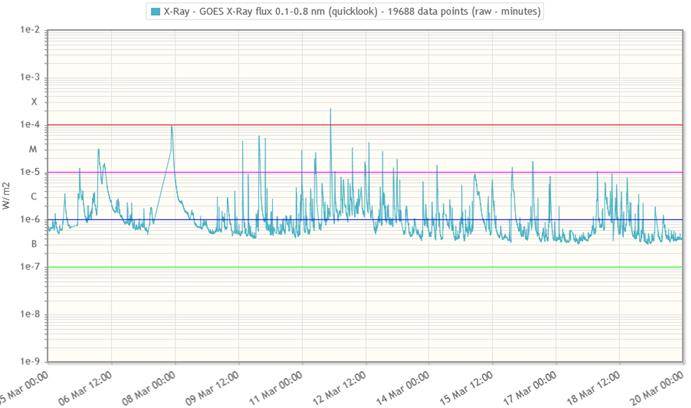
NOAA 2297 produced its strongest flare on 11 March. Peaking at 16:22UT, the X2.1 event lasted only for 18 minutes. At the time, NOAA 2297 was a very compact, but also very complex sunspot group displaying multiple delta structures, i.e. sunspots with opposite magnetic polarity within the same penumbra. A coronal mass ejection (CME) was associated with this flare, but, as can be seen in the extreme ultraviolet (EUV) picture underneath at 16:32UT, most of the material was ejected to the east (left) and not to the Earth.
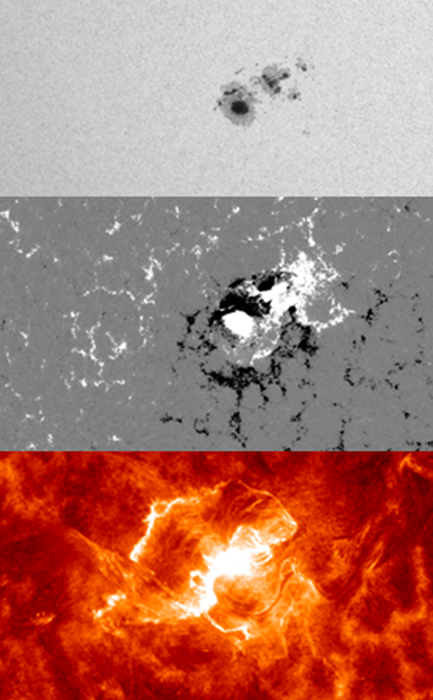
However, the most interesting event in this region took place early on 15 March, when NOAA 2297 produced a long duration C9.1 flare peaking at 02:13UT. This relatively modest flare was accompanied by a mild proton enhancement. Most importantly, also an asymmetric partial halo CME was observed that had a plane of the sky speed of 700 km/s. Though the bulk of this CME seemed to be directed away from Earth, a glancing blow was expected. A movie on NOAA 2297's evolution, the C9 flare and the associated CME can be seen at http://youtu.be/s7USVXBDlO8

The ACE satellite observed a shock in the solar wind parameters shortly after 04:00UT on 17 March, which is only 50 hours after the flare. Solar wind speed jumped from 400 km/s to slightly above 500 km/s, then gradually increased over the next few hours to a maximum of nearly 700 km/s. Except for a brief interruption between 09:00 and 11:00UT, the vertical component of the interplanetary magnetic field was consistently southward at about -20 nT from around 05:00UT till 23:00UT. This resulted in a severe geomagnetic storm (Kp = 8; see Note 2) lasting most of the second half of 17 March. Also Dourbes recorded a strong (K = 7) geomagnetic storm.
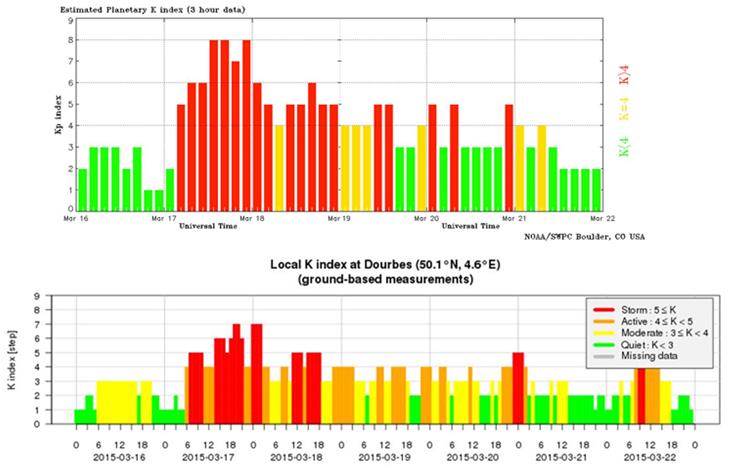
The evaluation of the strength of a geomagnetic storm is based on the Dst index, short for Disturbance storm time (see Note 3). It is expressed in nanoteslas (nT) and is based on the average value of the horizontal component of the Earth's magnetic field measured hourly at four near-equatorial geomagnetic observatories. Because it measures a depression of the horizontal component, the Dst index during geomagnetic storms is actually negative. Dst-values between -50 and -100nT are usually associated with moderate geomagnetic storms, and values of -100 nT or less with intense storms. So far this solar cycle, we only had a handful of such intense storms, with 25 October 2011 (-134nT), 17 March 2013 (-132nT), and 09 March 2012 (-131nT) as some well-known examples.
However, the 17 March 2015 storm really dwarfs these storms, as the provisional Dst-value for that day reached -228nT, making this by far the strongest geomagnetic storm so far during SC24. In fact, we have to go back all the way to 15 May 2005 (maximum Dst of -247nT) to find an even stronger geomagnetic storm. Nonetheless, to put things in perspective, during the very intense geomagnetic storms of 28-29 October 2003 and 13-14 March 1989, Dst-values of resp. -383nT and -589nT were recorded (source: Kyoto World Data Center)!

As could be expected from such strong storms, aurora were visible from countries well south of the normal polar light regions. So no surprise, but still quite rare, that polar lights were photographed and reported from France (Vosges, Picardie,...), Germany, the Czech Republic, and the middle of Russia. Underneath a screenshot from a movie made by Vincent van Leijen from the northern part of the Netherlands (https://www.flickr.com/photos/fotovins/16839832726/). There have also been some reports on issues with GPS signals and with (amateur) radio communication bands.
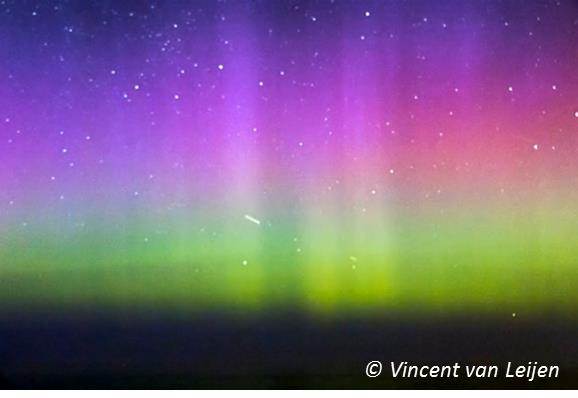
Note 1: More info on the flare-abundant active region NOAA 1515 is in the news items at http://stce.be/news/147/welcome.html from 6 July 2012 and at http://stce.be/news/148/welcome.html from 10 July 2012.
Note 2: More info on the Kp-index is in this news item from 26 March 2014 at http://stce.be/news/243/welcome.html
Note 3: More info on the Dst-index and data can be found at INGV (http://roma2.rm.ingv.it/en/themes/23/geomagnetic_indices/27/dst_index ), at NOAA (http://www.ngdc.noaa.gov/stp/GEOMAG/dst.html ), at the Kyoto WDC (http://wdc.kugi.kyoto-u.ac.jp/dstdir/dst2/onDstindex.html ), and at the SWRI/Image (http://pluto.space.swri.edu/image/glossary/dst.html).
Credits: Imagery for the movie was taken from SDO (http://sdo.gsfc.nasa.gov/), PROBA2 (http://proba2.oma.be/ssa), and SOHO (http://sohowww.nascom.nasa.gov/).
12th European Space Weather Week, 23-27 November 2015, Belgium
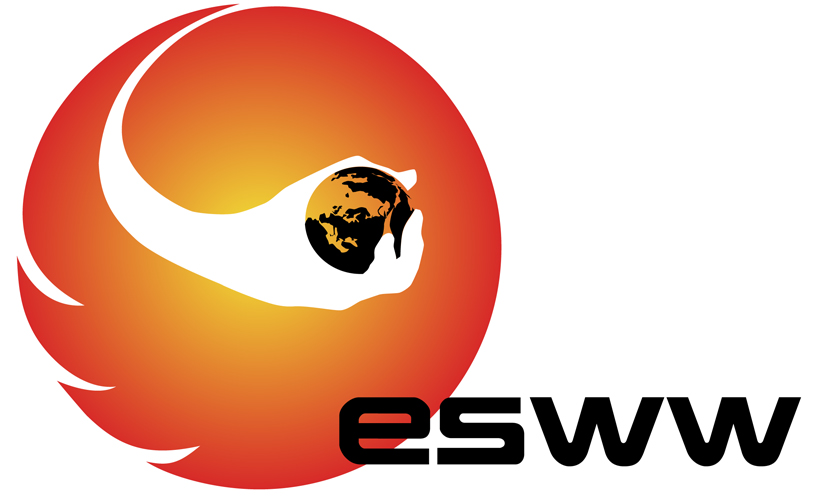
The ESWW is the main annual event in the European Space Weather calendar. The agenda will be composed of plenary/parallel sessions, working meetings and dedicated events for service end-users. The ESWW will again adopt the central aim of bringing together the diverse groups in Europe working on different aspects of Space Weather. This includes but is not limited to the scientific community, the engineering community, applications developers, service providers and end-users.
Following an excellent response to the call for session proposals issued in January, the Programme Committee is pleased to invite contributions to a list of sessions, addressing a wide range of scientific and application related themes. Each session is split into a poster and oral part. The poster programme emphasizes discussion and interaction between people. The oral part will consist of both invited and contributed papers.
The full session list is presented on http://www.stce.be/esww12/program/sessions.php
Deadline for submissions is May 13, 2015.
Key parts of the European Space Weather Weeks are the working meetings. These meetings provide the opportunity for participants to meet in smaller groups and address key issues in a style that complements the sessions. A working meeting aims at active participation or interaction between the participants. The participants work and discuss on a predefined theme or problem heading towards an outcome or target.
A working meeting is a 1.5-hour informal afternoon meeting with NO poster contributions. The conveners provide a title and abstract, those are put online. The title will appear in a handy printed program booklet. Working Meetings are open to the ESWW11 participants.
Submission will be open via the Conference Website http://www.stce.be/esww12/ from April 1, 2015.
Deadline for submissions is May 13,2015.
The European Space Weather Week is also the place to organize private Business Meetings. ESWW provides a room, projection material, lunch or coffee if needed. The organizers invite the participants and are asked to cover rental expenses of the room used. These Business Meetings will not appear in the published program.
Requests can be sent to petra.vanlommel@oma.be
Rooms are allocated upon availability.
Looking forward,
Mauro Messerotti (Chair, PC), Alexi Glover (Vice Chair, PC), Ronald Van der Linden (Chair, LOC)
On March 17, the space weather forecaster sent out an alert to warn for the impact of a solar magnetic cloud. Indeed, the cloud caused the largest geomagnetic storm of this solar cycle. The impact was also seen in our earth atmosphere as a dramatic increase in free electrons (Vertical Total Electron Content, VTEC) above southern and middle Europe and a decrease above northern Europe. The following day, the VTEC remained low above northern and middle Europe.
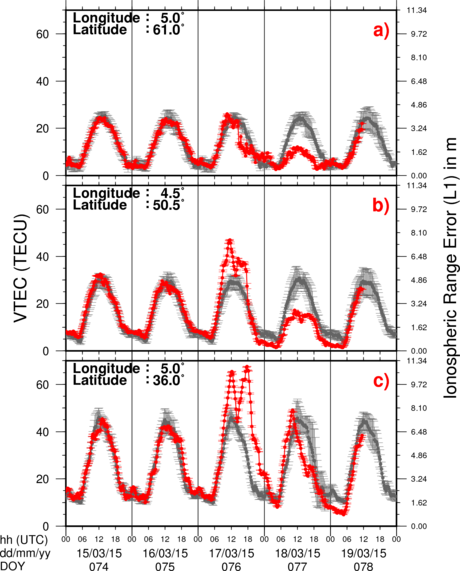
Check
http://gnss.be/Atmospheric_Maps/ionospheric_event.php?date=2015-03-17
Solar activity has been low to moderate. The week was initially dominated by NOAA AR 2297 (magnetic configuration beta-gamma-delta throughout the week) as it continued its journey over the western hemisphere to depart around the limb later in the week. Two M1 flares originated from this region with the largest an M1.6 peaking at 10:58UT March 16. Several additional high class C flares were produced by this region. NOAA region 2302 located around the same longitude as 2297 but in the northern hemisphere, was the source of most flaring activity in the time frame of March 18 to March 20/21 midnight. The strongest flare from this region was a C9.3 flare peaking at 07:51 March 18. Very many more C flares were observed from this region decreasing in magnitude over the mentioned time frame with NOAA 2297 causing two other high level C flares in between. With both these regions departing over the western limb, and the rest of the disc largely devoid of significant active regions flaring activity was mostly quiet over the weekend apart from a C1 flare originating from beyond the north-eastern limb.
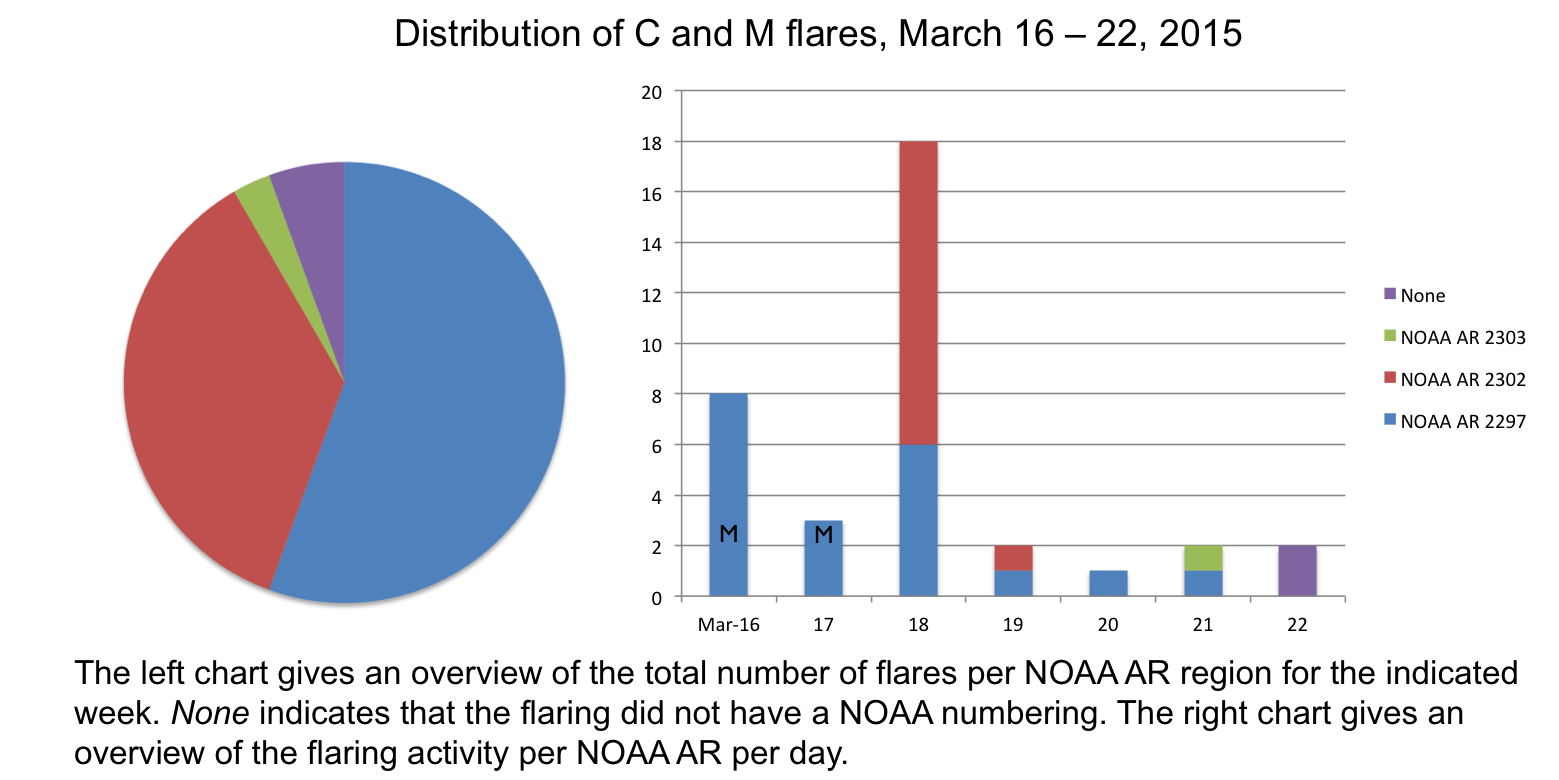
However, over the course of the weekend several new regions developed on disc although most seem to have rather simple magnetic configurations. The most complex region on disc (beta-gamma) is NOAA region 2305 which rotated on disc in the southern hemisphere, although it has yet not produced any significant flaring. In addition to the CME of early March 15 (previous reporting period) NOAA 2297 produced another partial halo CME as it was located right on the western limb. It was predicted not to have any possible influence on Earth although in retrospect it is not excluded that the disturbed solar wind conditions (see below) observed over the weekend are related to this event.
| DAY | BEGIN | MAX | END | LOC | XRAY | OP | 10CM | TYPE | Cat | NOAA |
| 16 | 1039 | 1058 | 1117 | S17W39 | M1.6 | 2N | 1 | 2297 | ||
| 17 | 2249 | 2334 | 2348 | S21W56 | M1.0 | 2N | 110 | III/1II/2 | 1 | 2297 |
| LOC: approximate heliographic location | TYPE: radio burst type |
| XRAY: X-ray flare class | Cat: Catania sunspot group number |
| OP: optical flare class | NOAA: NOAA active region number |
| 10CM: peak 10 cm radio flux |
The solar wind conditions were dominated by the arrival of the March 15 CME causing the largest geomagnetic storm of the cycle. On March 17, around 04:00UT, the solar wind speed jumped abruptly from around 410 km/s to over 500 km/s. The total interplanetary magnetic field (IMF) increased from 8-10 nT to 24-28 nT. The speed continued to increase and reached around 11:00UT that day a peak of more than 670 km/s. The IMF peaked at 35 nT. Bz was predominantly negative during the event, attaining peaks down to -27 nT. Severe geomagnetic storm conditions were recorded at the planetary level (Kp reaching 8), strong geomagnetic storm conditions were measured in Dourbes (K Dourbes 7).
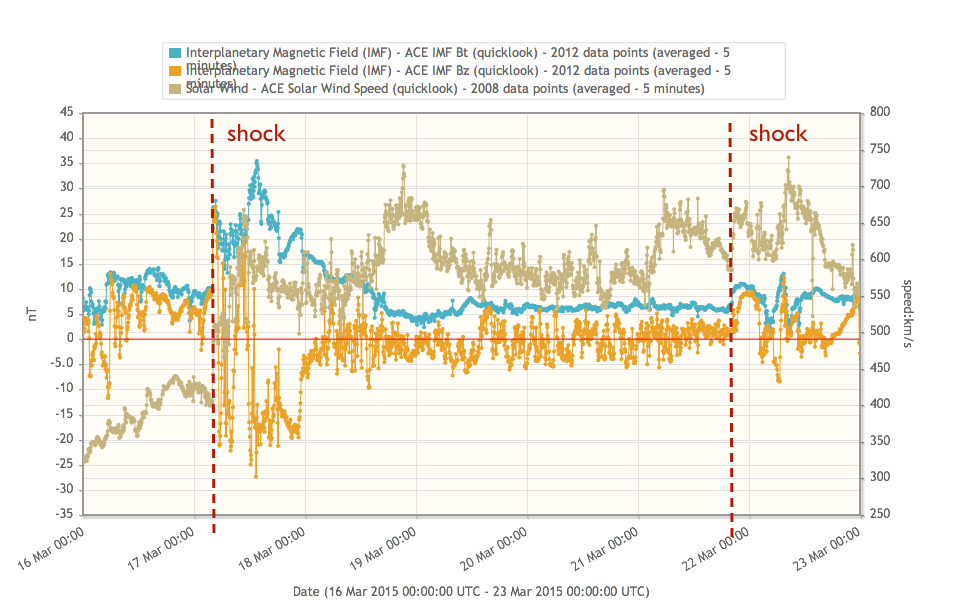
Agitated solar conditions lasted throughout most of the week when the declining CME effects transitioned into high speed stream influence from a southern polar coronal hole, with speeds reaching over 750 km/s and magnetic field on average around 6.5 nT. The high speed stream influence was expected to subside and transition into the influence of an equatorial coronal hole with positive polarity.

A small shock was observed in the solar wind around 20:25 UT on March 21. The solar wind speed increased suddenly from around 580 km/s to around 650km/s while the IMF jumped from 6-7 nT to 10 nT. On March 22, between 01:00 and 02:00 UT, the magnetic field angle phi rotated into a positive sector with the IMF first dipping down and later reaching a maximum of 13-14 nT after 7:00UT with Bz reaching -9nT. The magnetic field angle phi rotated back into the negative sector before settling in the positive sector corresponding to a high speed stream early March causing a minor geomagnetic storm. The signature seemed to correspond to an interplanetary coronal mass ejection, but no source was identified.
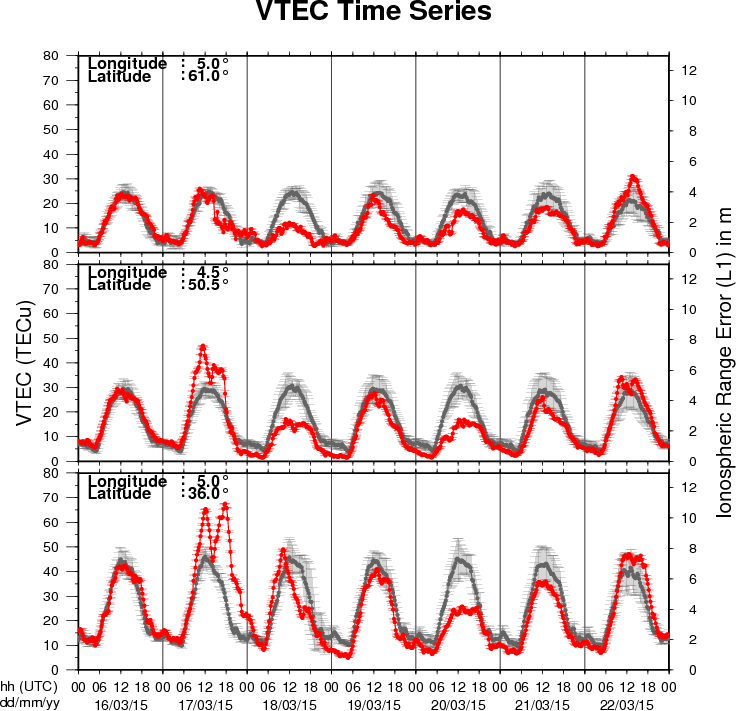
The figure shows the time evolution of the Vertical Total Electron Content (VTEC) (in red) during the last week at three locations:
a) in the northern part of Europe(N61°, 5°E)
b) above Brussels(N50.5°, 4.5°E)
c) in the southern part of Europe(N36°, 5°E)
This figure also shows (in grey) the normal ionospheric behaviour expected based on the median VTEC from the 15 previous days.
The VTEC is expressed in TECu (with TECu=10^16 electrons per square meter) and is directly related to the signal propagation delay due to the ionosphere (in figure: delay on GPS L1 frequency).
The Sun's radiation ionizes the Earth's upper atmosphere, the ionosphere, located from about 60km to 1000km above the Earth's surface.The ionization process in the ionosphere produces ions and free electrons. These electrons perturb the propagation of the GNSS (Global Navigation Satellite System) signals by inducing a so-called ionospheric delay.
See http://stce.be/newsletter/GNSS_final.pdf for some more explanations ; for detailed information, see http://gnss.be/ionosphere_tutorial.php
Start : 2015-04-13 - End : 2015-04-17
Space Weather Workshop is an annual conference that brings
industry, academia, and government agencies together in a lively
dialog about space weather. What began in 1996 as a conference for
the space weather user community, Space Weather Workshop has
evolved into the Nation's leading conference on all issues
relating to space weather.
The conference addresses the remarkably diverse impacts of space
weather on today's technology. The program highlights space
weather impacts in several areas, including communications,
navigation, spacecraft operations, aviation, and electric power.
The presentations and discussions at the Space Weather Workshop
also focus on identifying the highest priority needs for
operational services that can guide future research and identifying
new high-value capabilities that can be transitioned into
operations. The conference fosters communication among researchers,
space weather service providers, and users of space weather
services.
This year also marks the 50th anniversary of daily space weather
forecasting, so please join us in celebrating this important
milestone!
Website:
http://www.swpc.noaa.gov/content/annual-meeting
Start : 2015-04-28 - End : 2015-05-01
At present, solar researches and study of active late-type stars
achieve a significant advance thanks new observational facilities
and progress of the theory. The problems of an evolution of
activity at the billion year-time-scales start to be discussed.
Superflares were detected on stars younger than the Sun, and the
frequency of superflares occurrence was evaluated. The first
hypotheses were proposed for evaluation of flare activity level and
expected stellar wind fluxes at the epoch when the regular cycle on
the Sun was only established. Now it is a time to discuss further
directions of perspective investigations which are essential for
evaluation of space factor affecting on geo- and bio-sphere in
those epochs and space weather forecast.
Website:
http://www.tau.ac.il/institutes/advanced/cosmic/Conferences/2015-VarSITI_Superflares/VarSITI-2015_ISR.html
Start : 2015-05-02 - End : 2015-05-08
Start : 2015-05-18 - End : 2015-05-22
URSI AT-RASC 2015 will be the first edition of the newly
established triennial URSI Atlantic Radio Science Conference as one
of the URSI Flagship Conferences. AT-RASC 2015 will have an open
scientific program composed of submitted papers within the domains
covered by all ten Commissions of URSI.
Website: http://www.at-rasc.com/
Start : 2015-05-19 - End : 2015-05-22
The HELCATS project (see http://www.helcats-fp7.eu/) is
providing revolutionary new insights into solar wind structure
through combining the comprehensive analysis of heliospheric
imaging observations from the NASA STEREO spacecraft, in concert
with associated remote-sensing and in-situ measurements, with a
thorough assessment of appropriate techniques and models. The
project recognises that the advent of wide-angle imaging of the
inner heliosphere has revolutionised the study of transient and
quasi-stationary structures in the solar wind, in particular
Coronal Mass Ejections (CMEs) and Co-rotating Interaction Regions
(CIRs). Prior to the development of wide-angle imaging of the inner
heliosphere, signatures of such solar wind features could only be
observed within a few solar radii of the Sun, and in the vicinity
of a few near-Earth and interplanetary probes making in-situ
measurements of the solar wind. Heliospheric imaging has, for the
first time, filled that vast and crucial observational gap.
We will debate, in particular, the emotive issue of how we
associate CMEs with related phenomena observed, for example, on the
Sun or in-situ. How do we define (without bias and the need for
assumptions such as the relationship between flares and CMEs), a
standard set of 'rules', both temporal and spatial, for making such
associations? Such standards are crucial when forward and
backward-projecting data.
Website:
http://www.affects-fp7.eu/helcats-meeting/
Start : 2015-05-25 - End : 2015-05-29
25-27 May 2015: BUKS 2015 - MHD waves: Observational aspects
from ground to space - MHD waves: Theory - where are we? - MHD
instabilities
27-28 May 2015: Ruderman Honorary meeting - Theory of linear MHD
waves - MHD waves instabilities - Non-linear waves in plasmas
29 May 2015: Joint BUKS/Ruderman's conferences excursion -
Boat excursion to Szentendre, Visegrad and Esztergom
Website:
http://swat.group.shef.ac.uk/Conferences/BUKS_2015/index.html
Start : 2015-06-01 - End : 2015-06-05
Check the website for more information.
Website:
http://ws-sozopol.stil.bas.bg/
Start : 2015-06-01 - End : 2015-07-24
The Space Weather Summer School at Los Alamos National
Laboratory, established in 2011 under the founding Director Josef
Koller, is dedicated to space weather, space science and
applications. Every year we solicit applications for the Los Alamos
Space Weather Summer School. This summer school is sponsored and
supported by a number or organizations at LANL. This year our top
sponsors include the Los Alamos Institute of Geophysics, Planetary
Physics and Signatures (IGPPS) and the Laboratory Directed Research
and Development Office (LDRD). The summer school brings together
top space science students with internationally recognized
researchers at LANL in an educational and collaborative
atmosphere.
Website:
http://www.swx-school.lanl.gov/
Start : 2015-06-08 - End : 2015-06-12
The RadioSun Workshop and Summer School 2015 is the fourth
international academic seminar supported by the International
Research Staff Exchange Scheme of the Seventh Fromework Programme
of the European Union (FP7-IRSES-295272-RADIOSUN). The aims of this
project are to establish close research interaction and
collaboration between the key EU and non-EU research groups
involved in the research of the Sun in the radio band;
qualitatively advance our knowledge of the physical processes
operating in the solar atmosphere, the basic mechanisms responsible
for its evolution and dynamics and its effect on the Earth; and
provide younger researchers with extensive training in relevant
research techniques and with universal transfer.
Website:
http://www2.warwick.ac.uk/fac/sci/physics/staff/research/davidpascoe/radiosun
Start : 2015-06-09 - End : 2015-06-12
The last five years have seen substantial progress in our
understanding of the solar dynamo, fueled by continuing advances in
observations and modeling. With the launch of NASA's Solar Dynamics
Observatory (SDO) in 2010 came an unprecedented window on the
evolving magnetic topology of the Sun, highlighting its intricate
3D structure and global connectivity. The Helioseismic Magnetic
Imager (HMI) instrument on SDO in particular has provided
potentially transformative yet enigmatic insights into the internal
dynamics of the solar convection zone that underlie the dynamo.
Attempts to detect subsurface convective motions from helioseismic
inversions have yielded only upper limits on the large-scale
convective amplitude, challenging our understanding of global solar
convection. Yet, potential signatures of giant cells have been
detected in photospheric Dopplergrams. Estimates of the meridional
flow from HMI and complementary instruments (SOHO/MDI and GONG)
have been equally tantalizing and enigmatic. Several disparate
techniques, including local and global helioseismic inversions and
correlation tracking of surface features, have yielded evidence of
a multi-cellular meridional flow but they differ on the detailed
flow structure and amplitude. This multi-cellular meridional flow
has potentially profound implications for flux-transport dynamo
models that previously assumed a very different structure with a
single circulation cell per hemisphere.
Website:
https://www2.hao.ucar.edu/Workshop/Solar-Dynamo-Frontiers
Start : 2015-07-05 - End : 2015-07-09
We would like to invite you to submit contributed abstracts to
the parallel session "The science of space weather: progressing our
understanding" at the 2015 UK National Astronomy Meeting from 5-9
July (http://nam2015.org). The abstract-submission deadline is 1
April 2015. Observers, modellers, and theoreticians are all
welcome. We also welcome participation from end users interested in
how the science of space weather is advancing.
The science of space weather: progressing our understanding
The goal of this session is to provide an opportunity to discuss
the scientific research that underpins space weather and how a new
generation of operational space weather measurements could best be
utilised to further progress our understanding. Specific topics are
likely to include 1) gaps in our understanding of space weather and
how to resolve them, 2) new space and ground-based data that are
needed, 3) new science that can be carried out with the operational
space weather measurements being planned today.
This session is motivated by the fact that the UK has a strong
heritage in the science of the coupled Sun-Earth system, from both
an observational and theoretical perspective. This research is
increasingly being applied to the area of space weather monitoring
and forecasting, a topic that is now nationally recognised as an
important natural hazard for the UK (highly ranked in the National
Risk Register) and the subsequent opening of the Met Office Space
Weather Operations Centre in 2014.
Up until now, both the research and the space weather monitoring
and forecasting have utilised mainly data from instrumentation
(both space- and ground-based) designed to answer pertinent
scientific questions, though some operational instruments (e.g. the
X-ray and particle detectors on NOAA's GOES spacecraft) are also
widely exploited for scientific use. However, there is now growing
interest in deploying more instruments, in space and on the ground,
designed to support operational space weather services. Such
operational measurements can facilitate new science, as
demonstrated by the extensive research use of GOES data, but it is
important that the limitations imposed by operational needs are
discussed.
Website: http://nam2015.org/
Start : 2015-07-13 - End : 2015-07-24
The CISM Summer School is intended to give students a
comprehensive immersion in the subject of space weather: what it
is, what it does, and what can be done about it. Space weather is
many things: beautiful when seen through the eyes of a sun-viewing
telescope, fascinating when studied for its alien worlds of
magnetic structures and phenomena, awesome when witnessed as a
solar eruption or auroral storm, and devastating to the users of
services it disrupts. Space weather links the Sun, the Earth, and
the space in between in a branching chain of consequences. Weather
systems on the Sun can spawn interplanetary storms of colossal size
and energy that envelop the whole planet in electrical hurricanes.
Such storms attack high-tech, complex, and expensive technological
systems that provide much of the infrastructure that allows modern
society to function.
Website:
https://www2.hao.ucar.edu/Events/2015-CISM-Summer-School
Start : 2015-07-21 - End : 2015-07-23
The conference will review past and recent achievements, as well
as future challenges in the field of solar coronal loop
physics.
Website:
http://www.damtp.cam.ac.uk/user/astro/cl7/index.html
Start : 2015-07-28 - End : 2015-08-04
Heliophysics is all of the science common to the field of the
Sun-Earth connections. This fast-developing field of research
covers many traditional sub-disciplines of space physics,
astrophysics, and climate studies. The NASA Living with a Star
program, with its focus on the basic science underlying all aspects
of space weather, acts as a catalyst to bring the many research
disciplines together to deepen our understanding of the system of
systems formed by the Sun-Earth connection.
Website:
http://www.heliophysics.ucar.edu/
Start : 2015-07-30 - End : 2015-08-06
The 34th International Cosmic Ray Conference (ICRC) will be held
from July 30 to August 6, 2015, in The Hague, The Netherlands. It
is an important and large conference in the field of Astroparticle
Physics. The ICRC covers: cosmic-ray physics, solar and
heliospheric physics, gamma-ray astronomy, neutrino astronomy, and
dark matter physics.
Website: http://icrc2015.nl
Start : 2015-08-31 - End : 2015-09-04
The purpose of this conference is to discuss the latest
questions and results in solar and stellar physics. Solar and
stellar seismology will be one particular focus but contributions
on all aspects of solar-stellar relations will be welcome. We aim
to establish links and synergies between the day- and night-time
fields of astrophysics.
Website:
http://www.iac.es/congreso/solarnet-3meeting/
Start : 2015-09-02 - End : 2015-09-04
The Workshop will address how the joint exploration of the
corona and inner heliosphere will lead to advances in our
understanding of coronal heating and solar wind acceleration, the
magnetic and plasma structure of the heliosphere, and the
acceleration of energetic particles at shocks and flares. The
workshop will inspire research that will make use of SO and SPP
observations within the context of the NASA Heliophysics
Observatory System and identify key areas for preparatory research.
Synergistic observations from other ground based and space based
assets will also be addressed.
Website:
http://www.solarprobeplus.org/2015/
Start : 2015-09-06 - End : 2015-09-13
The International Workshop and School on solar system plasma
turbulence, intermittency and multifractals (STORM 2015) focus on
the quantitative experimental, theoretical and numerical
investigation of turbulence, intermittency, fractal/multifractal
features, waves and coherent structures interaction, criticality
and non-linear cross-scale coupling. As widely documented by
in-situ satellite measurements and remote or ground-based
observations, turbulence, intermittency and dynamical complexity
are quite ubiquitous processes observed in the dynamics of solar,
planetary and interplanetary plasmas, as well as in the dynamical
evolution of proxies linked to magnetospheric and ionospheric
variability.
Unfolding the spatio-temporal structure of magnetic field and
plasma fluctuations from experimental observations and numerical
simulations provides further insight on the structure of plasma
turbulence and intermittency. On the theoretical side, the
understanding of such complex dynamical behavior cannot be simply
surmised from the basic fluid/kinetic equations, but instead
requires novel theoretical, experimental and data analysis
approaches. The workshop is a forum to present and discuss latest
results in these fields. The purpose of the school is to give to a
young audience of Graduate, Ph.D. students, and postdoc scientists,
which ideally represents the next generation of scholars in the
physics of space plasmas, an overall view of both theoretical and
data analysis tools apt to fully exploit unique and unprecedented
observations that will be provided by future upcoming mission like
Solar Orbiter and Solar Probe Plus.
Website:
http://www.spacescience.ro/conferences/storm2015/
Start : 2015-09-14 - End : 2015-09-18
The aim of RADECS conferences is to provide an annual European
forum for the presentation and discussion of the latest advances in
the field of radiation effects on electronic and photonic
materials, devices, circuits, sensors, and systems. The scope of
the conference encompasses technological processes and design
techniques for producing radiation tolerant systems for space,
aeronautical or terrestrial applications, as well as relevant
methodologies for their characterization and qualification. The
conference features a technical program, an Industrial Exhibition,
and one day tutorial or "short course" on radiation effects. The
technical program includes oral and poster sessions and round
tables.
Website:
http://www.radecs2015.org/
Start : 2015-09-21 - End : 2015-09-26
A good understanding of solar-terrestrial processes is
fundamental to modelling the influence of solar variability on the
Earth's environment and climate. To capture all the physical
aspects of the solar wind-magnetosphere-ionosphere-atmosphere
interaction, and also the impact of solar variability on climate,
the Sun-Earth system has to be studied as a whole. The main purpose
of this school is to provide graduate, PhD students and also young
post-doc researchers with a global view of the main physical
processes by which solar variability affects the Earth's
environment. In addition, an overview of different data analysis
and methods for describing solar-terrestrial relations will be
given. The school will provide a mix of lectures and activities
requiring students participation.
Website:
http://www.cifs-isss.org/
Start : 2015-10-05 - End : 2015-10-09
This CSPM-2015 scientific meeting will cover various aspects of
solar dynamic and magnetic phenomena which are observed over the
entire electromagnetic spectrum: white-light, Hα, Ca II,
and radio from ground and in a variety of other wavelengths (white
light, UV and EUV, and X-rays) from space. Emphasis will also be
placed on instrumentation, observing techniques, and solar image
processing techniques, as well as theory and modelling through
detailed radiative transfer in increasingly realistic MHD models.
The long-term (cyclic) evolution of solar magnetism and its
consequence for the solar atmosphere, eruptive phenomena, solar
irradiation variations, and space weather, will be in focus. Here,
special attention will be devoted to the long-term observations
made in Coimbra and also to the results of the SPRING / SOLARNET
and SCOSTEP VarSITI studies. In particular, the weak solar activity
during the current solar maximum will be discussed. Finally, since
this meeting is organised around the 90th anniversary of performing
the first spectroheliographic observations in Coimbra, a session
will be specially dedicated to new solar instruments (both
ground-based and space-borne) that will give access to unexplored
solar atmospheric features and dynamic phenomena over the coming
years.
Website:
http://www.mat.uc.pt/~cspm2015/
Start : 2015-10-19 - End : 2015-10-23
The workshop aims to gather experts from the various fields of
remote sensing observations of the inner heliosphere,
including white light, EUV, and radio observation,
together with modellers in order to tackle key outstanding science
and space weather operational issues, establish closer
working relations, and devise the best ways to move the field
forward as a whole. In addition, the science learned from remote
Âsensing observations is critical to improving our
capabilities of space weather forecasting. The workshop
aims to look at ways in which we can more easily and efficiently
share and access the various types of data between individual
groups and subÂcommunities and to officially launch the
IPS Common Data Format v1.0 (IPSCDFv1.0) now in use. It also aims
to allow investigations into ways in which we model the inner
heliosphere looking at the advantages and disadvantages of the
available modelling, updates on present and future
remoteÂsensing capabilities, and investigating further
the ways in which these data sets all complement each other and are
necessary to gain knowledge and understanding of the fundamental
physical processes that occur within the inner heliosphere. These
are critical processes that are key to both Heliophysics science as
well as to spaceÂweather operations and forecasting.
Website:
http://www.sciesmex.unam.mx/workshop2015/
Start : 2015-11-10 - End : 2015-11-13
Observations of the Sun and Earth from space have revolutionized
our view and understanding about impacts of solar variability and
anthropogenic forcing on Earth climate. For more than three solar
cycles since 1978, the total and spectral solar irradiance (TSI and
SSI) and global terrestrial atmosphere/surface have been observed
continuously, enabling unprecedented quality data for Sun-climate
studies. The primary objective of this symposium is to convene
climate scientists, solar physicists, and experimentalists together
for a better understanding how Earth climate system changes and
responds to solar variability.
Website:
http://lasp.colorado.edu/home/sorce/news-events/meetings/2015-sun-climate-symposium/
Start : 2016-07-30 - End : 2016-08-07
The 41st COSPAR Scientific Assembly will be held in Istanbul,
Turkey from 30 July - 7 August 2016. This Assembly is open to all
bona fide scientists.
Website:
https://www.cospar-assembly.org/
Presentation given during a users' visit about the STCE operational space weather services and products.
http://www.spaceweather.eu/en/repository/show?id=558
Presentation given during a users' visit about the STCE operational space weather services and products.
http://www.spaceweather.eu/en/repository/show?id=559
Presentation given during a users' visit about the STCE operational space weather services and products.
http://www.spaceweather.eu/en/repository/show?id=560
Presentation given during a users' visit about the STCE operational space weather services and products.
http://www.spaceweather.eu/en/repository/show?id=561
Presentation given during a users' visit about the STCE operational space weather services and products.
http://www.spaceweather.eu/en/repository/show?id=562
Presentation given during a users' visit about the STCE operational space weather services and products.
http://www.spaceweather.eu/en/repository/show?id=563
Invited review submitted to the journal Revue E. This article is the first in a series of 3 articles.
De Zon, Helios, Sol, ... er bestaan vele namen voor die gele bol die dagelijks ons hemelgewelf doorkruist en onze warmte- en lichtbron bij uitstek is. Dankzij satellietwaarnemingen hebben we onze ster leren kennen als een dyna- misch en explosief hemelobject dat aan de basis ligt van het zogenaamde ruimteweer dat een belangrijke impact heeft op onze technologie.
http://www.spaceweather.eu/en/repository/show?id=564
On the occasion of the solar eclipse of March 20, 2015, we contributed to the March 2015 edition of the amateur astronomer journal 'Zenit'. We highlighted the outcome of LASCO onboard of SOHO and focussed on the role of the STCE on space missions like PROBA2, PROBA3 and Solar Orbiter.
The text is written in Dutch.
http://www.spaceweather.eu/en/repository/show?id=565
e Zon, Helios, Sol, ... er bestaan vele namen voor die gele bol die dagelijks ons hemelgewelf doorkruist en onze warmte- en lichtbron bij uitstek is. Dankzij satellietwaarnemingen hebben we onze ster leren kennen als een dyna- misch en explosief hemelobject dat aan de basis ligt van het zogenaamde ruimteweer dat een belangrijke impact heeft op onze technologie.
Bijdrage aan een editie 'Zonnestormen en hun impact op elektrische netten' van het Revue E tijdschrift - 130ste jaargang - nr 2-2014(juin/juni 2014)
http://www.spaceweather.eu/en/repository/show?id=566
The Earth’s magnetic field creates a cavity in interplanetary space, called the magnetosphere. Physical processes in this region of space determine how mass and energy from the solar wind reach the ionosphere, the partially ionized upper atmosphere. Magnetosphere and ionosphere are strongly coupled. Together, they modulate the impacts of solar activity on man and technology. This paper presents a brief overview of the magnetosphere-ionosphere system under quiet conditions, followed by a summary of the most important dynamic effects during disturbed conditions.
Contribution to the edition 'Zonnestormen en hun impact op elektrische netten' van het Revue E tijdschrift - 130ste jaargang - nr 2-2014(juin/juni 2014)
http://www.spaceweather.eu/en/repository/show?id=567
The Earth’s magnetic field varies on a wide range of timescales, from long time trends caused by internal processes to rapid fluctuations caused primarily by solar events. Nowadays, the magnetic field is continually being monitored by worldwide networks of observatories. Different indices have been developed to characterise the magnetic activity, and various services exist to alert users in case of a magnetic disturbance.
Contribution to the edition 'Zonnestormen en hun impact op elektrische netten' van het Revue E tijdschrift - 130ste jaargang - nr 2-2014(juin/juni 2014)
http://www.spaceweather.eu/en/repository/show?id=568
Presentation given at the workshop Six Years of SOLAR/SOLSPEC mission on ISS - Achievements and prospects.
http://www.spaceweather.eu/en/repository/show?id=569
Presentation given at the workshop Six Years of SOLAR/SOLSPEC mission on ISS - Achievements and prospects.
http://www.spaceweather.eu/en/repository/show?id=570
Presentation given at the workshop Six Years of SOLAR/SOLSPEC mission on ISS - Achievements and prospects.
http://www.spaceweather.eu/en/repository/show?id=571
Presentation given at the workshop Six Years of SOLAR/SOLSPEC mission on ISS - Achievements and prospects.
http://www.spaceweather.eu/en/repository/show?id=572
Presentation given at the workshop Six Years of SOLAR/SOLSPEC mission on ISS - Achievements and prospects.
http://www.spaceweather.eu/en/repository/show?id=573
Presentation given at the workshop Six Years of SOLAR/SOLSPEC mission on ISS - Achievements and prospects.
http://www.spaceweather.eu/en/repository/show?id=574
Presentation given at the workshop Six Years of SOLAR/SOLSPEC mission on ISS - Achievements and prospects.
http://www.spaceweather.eu/en/repository/show?id=575
Presentation given at the workshop Six Years of SOLAR/SOLSPEC mission on ISS - Achievements and prospects.
http://www.spaceweather.eu/en/repository/show?id=576
Presentation given at the workshop Six Years of SOLAR/SOLSPEC mission on ISS - Achievements and prospects.
http://www.spaceweather.eu/en/repository/show?id=577
Presentation given at the workshop Six Years of SOLAR/SOLSPEC mission on ISS - Achievements and prospects.
http://www.spaceweather.eu/en/repository/show?id=578
Presentation given at the workshop Six Years of SOLAR/SOLSPEC mission on ISS - Achievements and prospects.
http://www.spaceweather.eu/en/repository/show?id=579
Presentation given at the workshop Six Years of SOLAR/SOLSPEC mission on ISS - Achievements and prospects.
http://www.spaceweather.eu/en/repository/show?id=580
Presentation given at the workshop Six Years of SOLAR/SOLSPEC mission on ISS - Achievements and prospects.
http://www.spaceweather.eu/en/repository/show?id=581
Presentation given at the workshop Six Years of SOLAR/SOLSPEC mission on ISS - Achievements and prospects.
http://www.spaceweather.eu/en/repository/show?id=582